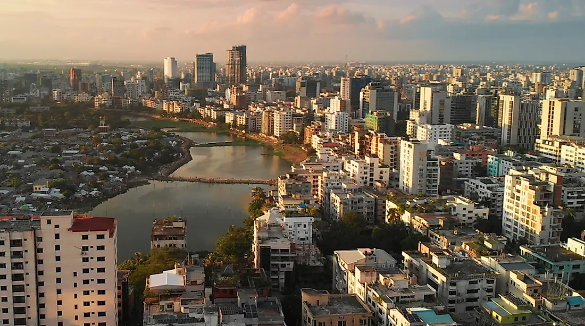The History of Bangladesh: Located on the banks of the Ganges River, Bangladesh is one of the most densely populated countries on Earth, with a majority Muslim population. West Bengal and the province of Bengal used to be located in the eastern part of Bengal. It is now the Indian state of West Bengal. It became the Pakistani province of East Bengal (later called East Pakistan), one of Pakistan’s five provinces split by 1,100 miles (1,800 kilometers) of Indian territory after India’s partition in 1947. ‘East Pakistan’ then became the independent country of Bangladesh in 1971, with Dhaka as its capital.
Relief-The History of Bangladesh
Bangladesh occupies about the eastern two-thirds of the deltaic plain formed by the Padma (Ganges [Ganga]) and Jamuna (Brahmaputra) rivers. Except for a few higher areas of jungle-covered old alluvium (rising to about 100 feet [30 meters]) in the northwest and north-central portions of the plain — in the Barind and Madhupur Tracts, respectively — the plain is a flat surface of recent alluvium with a gentle slope and an elevation of fewer than 30 feet (9 meters) above sea level. In the northeast and southeast — in the Sylhet and Chittagong Hills areas, respectively — alluvial plains give way to ridges that run mostly north-south and are part of the mountains that divide Bangladesh from Myanmar and India. Bangladesh is bounded on the south by the Sundarbans, a vast tract of swampy deltaic forest.
The Barind is a slightly raised triangular wedge of land located in northern Bangladesh between the floodplains of the upper Padma and Jamuna rivers. The Bhar Basin stretches southeast from the Barind for approximately 100 miles (160 kilometers) to the junction of the Padma and Jamuna. This region gets inundated during the summer monsoon season, reaching a depth of more than ten feet in some spots (3 meters). The western portion of the basin is drained by the enormous marshy region known as the Chalan wetlands, also called Chalan Lake. The Jamuna floodplains, located north of the Bhar Basin and east of the Barind, extend from the Assam border in the north to the Padma and Jamuna confluence in the south. The Jamuna River dominates the area, regularly overflowing its banks during disastrous floods. The floodplain of the lower Padma is located south of the Bhar Basin.
The Madhupur Tract is located in north-central Bangladesh, east of the Jamuna floodplains. It is a high plateau with hillocks varying in height from 30 to 60 feet (9 to 18 meters) that contour agricultural valleys. The Madhupur Tract is home to sal trees, whose hardwood is equivalent to teak value and function. In northeastern Bangladesh, east of the Madhupur Tract lies an area recognized as the Northeastern Lowland. It includes the southern and southwestern sections of the Sylhet region (including the Surma River’s valley plain) and the northern part of the Mymensingh area and is known for its numerous lakes. The Sylhet Hills, located in the region’s far northeast, is a collection of hillocks and hills varying from around 100 feet (30 meters) to more than 1,100 feet (330 meters).
In east-central Bangladesh, the Brahmaputra River (the Old Brahmaputra River) shaped the Meghna River’s flood basin, containing the low and rich Meghna-Sitalakhya Doab (the land area between those rivers). The Titas distributary replenishes this region, and land areas are generated and altered by silt and sand deposition in the Meghna River’s riverbeds, particularly between Bhairab Bazar and Daudkandi. This region is home to Dhaka.
The Middle Delta Basins in southern Bangladesh encompass the large lakes in the central region of the Bengal Delta, south of the upper Padma. The basin covers an area of approximately 1,200 square miles (3,100 square km). The Immature Delta is a geographical mass in southern Bangladesh that borders the Bay of Bengal. A lowland covering approximately 3,000 square miles (7,800 square kilometers), the belt includes, in addition to the Sundarbans’ immense mangrove forest, the reclaimed and farmed plains to the north. The region immediately next to the Bay of Bengal is crisscrossed by a network of streams that wind their way around approximately rectangular islands. The Active Delta, located north of the Central Delta Basins and east of the Immature Delta, comprises the Dhaleswari-Padma Doab and a series of estuary islands ranging in size from the Pusur River to the southwest to the island of Sandwip near Chittagong in the southeast.
The History of Bangladesh:The Chittagong Region
Located south of the Feni River in southeastern Bangladesh. It is characterized by several hills, hillocks, valleys, and woods and is considerably distinct in appearance from the rest of the nation. The coastal plain is partially sandy and partly saline clay. It stretches southward from the Feni River to Cox’s Bazar and ranges from one to ten kilometers (1.6 to 16 km). Off the coast of Myanmar, the region has several offshore islands and one coral reef, St. Martin’s. In the extreme southeast, the hilly area known as the Chittagong Hill Tracts consists of low hills of soft rocks, primarily clay and shale. The ranges running north-south are usually less than 2,000 feet (600 meters) in elevation.
People of Bangladesh-The History of Bangladesh
Ethnic communities-The History of Bangladesh
The majority of Bangladesh’s population is Bengali, which refers to both an ethnic and linguistic group. The Bengali people are historically varied and have evolved due to several communities that settled in the region over several centuries. Perhaps the earliest settlers in the region were the Vedda peoples. According to certain ethnologists, they were followed by peoples from the Mediterranean and neighboring areas, notably those who spoke Indo-European languages. During the eighth century CE, many Arab, Persian, and Turkish ancestry immigrated to the subcontinent. By the early 13th century, they had established a presence in what is now Bangladesh. Thus, the assertion that current Bengali Muslims are all derived from lower-caste Hindus who converted to Islam is patently false. A sizable number descended from Muslims who arrived on the subcontinent from other parts of the world.
The History of Bangladesh: Non-Bengalis—mostly minor indigenous groups—make up a minuscule percentage of the population. The majority of these people live in the Chittagong Hill Tracts in the southeast, the country’s least inhabited region. Several groups are linked to the peoples of Myanmar (Burma), and the majority adhere to Buddhism. However, Hinduism and Christianity also have a sizable following. The Chakma, the Marma (Magh or Mogh), the Tripura (Tipra), and the Mro are the largest of the Chittagong Hill Tracts’ dozen or more ethnolinguistic tribes. The Khomoi (Kumi), the Kuki, and the Mizo (previously called Lushai) are lesser groups. Since the mid-1970s, ethnic tensions and recurrent violence have characterized the Chittagong Hill Tracts, where many long-established residents have opposed the inflow of Muslim Bengali newcomers.
In other regions of Bangladesh, indigenous minority peoples include the Santhal, the Khasi, the Garo, and the Hajang. The Santhal dwells in the country’s northwestern part, the Khasi in Sylhet’s Khasi Hills near the Indian state of Assam, and the Garo and Hajang in the country’s northeastern region.
Bangladeshi Languages
Bengali (Bangla), Bangladesh’s national language, is an Indo-Aryan language connected to Sanskrit. Like Pali and several other dialects of Prakrit in ancient India, Bengali evolved independently of the Aryan Brahman culture. The Pala monarchs of Bengal (8th–12th centuries), who were Buddhists and spoke Pali as their holy language, could not prevent the creation of a vernacular dialect known as Gaudiya Prakrit, which evolved into Bengali.
Bengali is the mother tongue of nearly all of Bangladesh’s inhabitants. Indigenous minority groups, on the other hand, have their languages and dialects, some of which are Tibeto-Burman. English is an Indo-European language that is widely spoken in metropolitan areas and among educated populations.
The History of Bangladesh: The Bengali language has two different styles: sadhu bhasa, which is more scholarly and contains many vocabularies originating from Sanskrit, and calit bhasa, the typical medium of casual speech, both spoken and written. Until the 1930s, all printed materials were written in sadhu bhasa, but calit bhasa is now the standard style for modern literature. Additionally, there are a variety of dialects. Numerous loanwords from Portuguese, English, Arabic, Persian, and Hindi are found in Bengali.
Religion
Most Bangladeshis adhere to Islam, declared the state religion in a 1988 constitutional amendment. Muslims arrived in Bengal around the beginning of the 13th century and rapidly expanded their dominance and influence, permanently altering their character and culture. Hinduism was the most prevalent religion when the Muslims came, while pockets of Buddhists and a few adherents of indigenous religions existed. Throughout the Mughal dynasty, Hindus were the majority (16th to 18th century). Even in the early 1870s, Bengal had more than 18 million Hindu population, compared to roughly 16 million Muslims. However, beginning in the 1890s, the balance started to change in favor of the Muslims.
Numerous factors contributed to the growth in the proportion of Muslims in the population. Perhaps the most notable was the work of ascetics and Sufis (practitioners of Sufism, a mystical branch of Islam), who converted lower-caste Hindus to Islam. Additionally, an inflow of Muslims from northern India and other nations was considerable.
The History of Bangladesh: Most Muslims are Sunni, while a tiny proportion is Shia, primarily descendants of Iranian immigration. Hindus are a sizable minority, whereas Roman Catholics and Buddhists account for a negligible population. The Chakma, Marma, and Mro are mainly Buddhist tribes of the Chittagong Hill Tracts. Local religions are practiced by portions of the Kuki, Khomoi, and Mro groups. While the majority of Mizo people are Christians, the Tripura people are Hindu.
Independence of Bangladesh-The History of Bangladesh
Immediately after Pakistan obtained independence as a nation with two separate areas, known as West Pakistan (now Pakistan) and East Pakistan (now Bangladesh), Bengali rights began. A lack of respect for Bengali culture and a disparaging attitude toward the Bengali community led to strained ties between the two sections of Pakistan after Partition in the early years of independence. Awami League, headed by East Pakistani Sheikh Mujibur Rahman (commonly known as Mujib) and headquartered in East Pakistan, won the national elections in December 1970. However, West Pakistani parties such as the Pakistan Peoples Party (PPP) refused to control. It sparked a period of unrest in December. Some Bihari communities got attacked due to rising tensions between Bengalis and Biharis, the Urdu-speaking populations who had relocated to East Pakistan from various regions of India following Partition and were pro-West Pakistani.
As a result of the unrest, the Pakistani Army interfered in eastern Pakistani affairs in March 1971. Local pro-Pakistan Bengalis and non-Bengalis, including Jamaat-e-Islami members, were recruited for its operations against Bengali groups. New Delhi exploited the influx of refugees as a justification to act militarily in early December 1971, when the violence was at its peak. On December 16, the Pakistani Army surrendered, ending the nine-month struggle that claimed the lives of between 300,000 and 3 million people, including hundreds of thousands of women.
Bangladesh’s Awami League, seen as “pro-Indian,” and its military and Bangladesh National Party (BNP), viewed as “pro-Pakistan” and “pro-Islamist,” have both attempted to influence the narrative after the conclusion of the war. For decades, this has hampered the transitional justice process and disappointed the relatives of victims.
After the conflict, Mujib rose to power and remained in charge for the rest of the country’s existence. A unique statute allowing for the arrest and prosecution of people suspected of “collaborating” with the Pakistani military was introduced by him.
The History of Bangladesh: Ziaur Rahman took control in 1975 after Mujib’s killing and began to alter the popular perception of the liberation struggle. Aside from civilians, he made a concerted effort to highlight military involvement in the battle. He freed the alleged war criminals and abolished the ban on the Jamaat-e-Islami (JI) movement. In the years that followed, his organization, the BNP, elevated some of its members convicted of war crimes to positions of power, thereby aggravating the plight of the victims.
The Committee for the Eradication of the Killers and Collaborators of 1971 was formed in the early 1990s by civil society actors and performed mock trials against alleged war criminals until that time. BNP administration brought sedition charges against organizers despite the committee’s lack of legal status.
Mujib’s daughter Sheikh Hasina, the Awami League’s current leader, benefited from the committee’s momentum in her fight for power against the BNP. She wanted to portray the events of 1971 as completely being the work of the Awami League.
While running for president in 2008, Sheikh Hasina promised to use the transitional justice system to bring war criminals to justice. Although the war crimes cases have been clouded by controversy, they have been commenced. Some have accused them of being used by Sheikh Hasina to punish and oust her opponents. Some fear that the proceedings’ politicized tone will make justice more challenging to get, which many survivors want.
Today in Bangladesh
Today, Sheikh Hasina has managed to consolidate her narrative of the 1971 battle to such a degree that, if one criticizes her party, they are viewed as charging liberation itself and hence regarded as anti-state.
People in Bihar who were stateless after the conflict and were only granted citizenship in 2008 by a Supreme Court decision are worried that those responsible for the rape and murder of Bihari women and girls would never be held accountable for their actions. Only atrocities committed against Bengalis are recorded in Bangladesh’s official memory, which the government has firmly established.
Thousands of Biharis are still living in camps today. It is said that they are “stranded Pakistanis” and pro-Pakistan collaborators because of their suspected involvement in the conflict.
Cruise Critic
CruiseDirect
Recommended Reads
- https://thetravelvirgin.com/big-cities-in-africa/
- https://thetravelvirgin.com/how-many-oceans-in-the-world/
- https://thetravelvirgin.com/top-50-hiking-trails-in-the-usa-2021/
- https://thetravelvirgin.com/the-10-best-hotels-and-vacation-rentals-in-lahore-pakistan-2021/
- https://thetravelvirgin.com/10-best-travel-destinations-to-find-your-husband-or-wife-finding-love-in-2021-bucket-list-love-tips-included/


